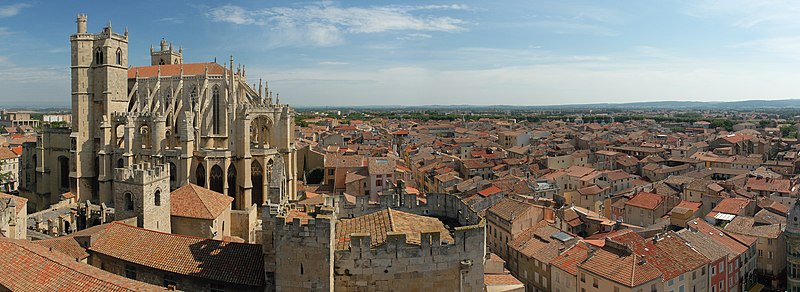Narbonne
| France | Main pages | Places | Other links |
|
Trustroots
{{ #if: 1VQT.jpg| |
{{ #if: *France |
{{ #if: Alsace • Aquitaine • Auvergne • Lower Normandy • Bourgogne • Brittany • Centre • Champagne-Ardenne • Corsica • Franche-Comté • Upper Normandy • Ile-de-France • Languedoc-Roussillon • Limousin • Lorraine • Midi-Pyrénées • Nord-Pas-de-Calais • Pays-de-la-Loire • Picardie • Poitou-Charentes • Provence-Alpes-Côte d'Azur • Rhone-Alpes|Alsace • Aquitaine • Auvergne • Lower Normandy • Bourgogne • Brittany • Centre • Champagne-Ardenne • Corsica • Franche-Comté • Upper Normandy • Ile-de-France • Languedoc-Roussillon • Limousin • Lorraine • Midi-Pyrénées • Nord-Pas-de-Calais • Pays-de-la-Loire • Picardie • Poitou-Charentes • Provence-Alpes-Côte d'Azur • Rhone-Alpes}} |
{{ #if: 242|*BW group}} {{ #if: 176|*CS group}} {{ #if: France|*Wikipedia}} {{ #if: France|*Wikivoyage}} {{ #if: France|*Hitchwiki}} |
| |||||||||||||||||||||||||
Narbonne is a city in France, situated in the region Languedoc-Roussillon. Capital of Narbonese Gaul and residence of Visigoth kings before it became an Archiepiscopal seat, Narbonne numbers close to 50,000 inhabitants. With its 173 square kilometres, (67 sq. mi.), the city of Narbonne boasts not only the largest city territory of the department but also the most diverse. Centred on the lower Aude valley, the city extends along its East-West axis from the Mediterranean Sea to the coastal buttresses of the Corbières Maritime Mountains, encompassing the La Clape limestone range. From North to South, it stretches from the Aude's current course to the edges of Sainte-Lucie Island, including more than half of the Bages-Sigean lakes.
HISTORY OF NARBONNE
Narbonne was established in Gaul in 118 BC, as Colonia Narbo Martius. It was located on the Via Domitia, the first Roman road in Gaul, built at the time of the foundation of the colony, and connecting Italy to Spain. Geographically, Narbonne was therefore located at a very important crossroads because it was situated where the Via Domitia connected to the Via Aquitania, which led toward the Atlantic across Toulouse and Bordeaux. In addition, it was crossed by the Aude River. Surviving members of Julius Caesar's Legio X Equestris were given lands in area that nowadays is know as Narbonne. Politically, Narbonne gained importance as a competitor to Massalia (Marseille). Julius Caesar settled veterans from his 10th legion there and attempted to develop its port while Marseille was revolting against Roman control. Among the amenities of Narbonne, its rosemary-flower honey was famous among Romans.
Later, the provincia of southern Gaul was named "Gallia Narbonensis", after the city, and Narbonne was made its capital. Seat of a powerful administration, the city enjoyed economic and architectural expansion. It was subsequently the capital of the Visigothic province of Septimania. It was part of the Emirate of Cordoba until conquered by the Franks after which it became part of the Carolingian Viscounty of Narbonne. In the 12th century, the court of Ermengarde of Narbonne (reigned 1134 to 1192) presided over one of the cultural centers where the spirit of courtly love was developed.
In the 11th and 12th centuries, Narbonne was home to an important Jewish exegetical school, which played a pivotal role in the growth and development of the Zarphatic (Judæo-French) and Shuadit (Judæo-Provençal) languages. Jews had settled in Narbonne from about the 5th century, with a community that had risen to approximately 2000 in the 12th century. At this time, Narbonne was frequently mentioned in Talmudic works in connection with its scholars. One source, Abraham ibn Daud of Toledo, gives them an importance similar to the exilarchs of Babylon[2] In the 12th and 13th centuries, the community went through a series of ups and downs before settling into extended decline.
More informations about the History of Narbonne on the wikipedia:Narbonne !
WHAT TO VISIT ?
|
File:Jpg narbonne-2.jpg The Old Town |
File:Les halles.jpg The Market Hall |
|
File:Narbonne 01.jpg The Archeveque Palace |
File:Photos-6-Narbonne 01.bmp The Castle |
More informations about the places to visit in Narbonne on the wikivoyage:Narbonne and even the Official Website of the Office of Tourism of Narbonne !
TIPS
Free Internet/Wifi Access
Here are some places where you can get some Internet/Wifi Access:
- Maison de la l'Emploi et de la Formation - Adress: 8 Avenue Maréchal Foch - Tel: 04.68.65.39.55
- Versus, Internet Café - Adress: 60, rue Droite - Tel: 04 68 32 95 27
Nice & Cheap Places to Eat
Nightlife
COUCHSURFERS
There are about 60 Couchsurfers in Narbonne and its area. You can check the CS Group of Narbonne or simply a couchsearch to find and contact them.
Meetings
There are sometimes some meetings organised in Narbonne, just check the CS Group of Narbonne to see what happen in the city and/or the Regional CS Group of Languedoc-Roussillon to see if there is any event in the area.
Coffee or a Drink
Here is a list of persons who are ready to have a drink with you and/or show you the city:
TRANSPORTATIONS
How to get to Narbonne
- By Car:
- By Plane:
- By Train:
Bus
Bicycles
IN CASE OF EMERGENCY
- Police Station:
Gendarmerie: 04 68 41 42 88
Commissariat: 04 68 90 38 50 or 17
- Health Urgency:
Tel: 15
- Hospital:
Centre Hospitalier: 04 68 42 60 00
Adress: Boulevard Docteur Lacroix
Clinique Les Genêts: 0826 207 407
Adress: Quai Vallière
- Fireman Station:
Tel: 18
- Embassy:
- Emergency Doctor:
LOCAL MEDIA MENTIONS
INTERESTED LINKS
_____________________________________________________________________________________________



